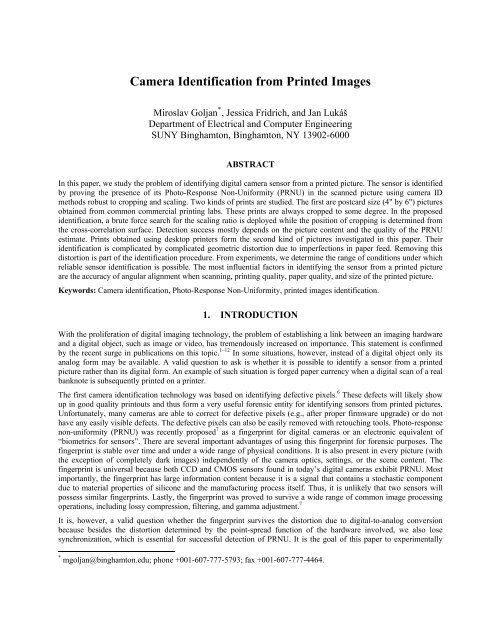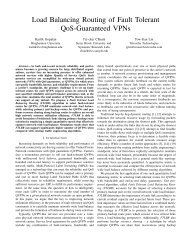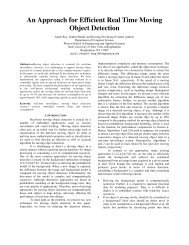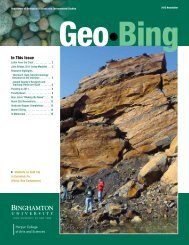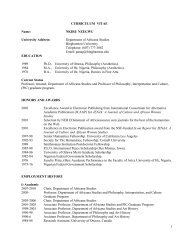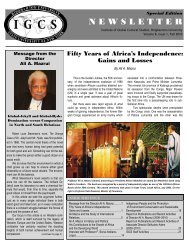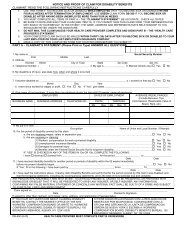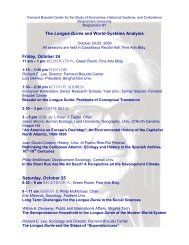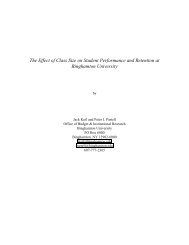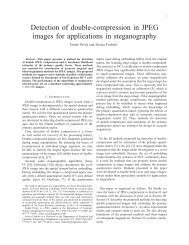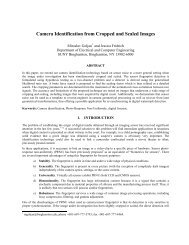Camera Identification from Printed Images
Camera Identification from Printed Images
Camera Identification from Printed Images
You also want an ePaper? Increase the reach of your titles
YUMPU automatically turns print PDFs into web optimized ePapers that Google loves.
<strong>Camera</strong> <strong>Identification</strong> <strong>from</strong> <strong>Printed</strong> <strong>Images</strong>Miroslav Goljan * , Jessica Fridrich, and Jan LukášDepartment of Electrical and Computer EngineeringSUNY Binghamton, Binghamton, NY 13902-6000ABSTRACTIn this paper, we study the problem of identifying digital camera sensor <strong>from</strong> a printed picture. The sensor is identifiedby proving the presence of its Photo-Response Non-Uniformity (PRNU) in the scanned picture using camera IDmethods robust to cropping and scaling. Two kinds of prints are studied. The first are postcard size (4" by 6") picturesobtained <strong>from</strong> common commercial printing labs. These prints are always cropped to some degree. In the proposedidentification, a brute force search for the scaling ratio is deployed while the position of cropping is determined <strong>from</strong>the cross-correlation surface. Detection success mostly depends on the picture content and the quality of the PRNUestimate. Prints obtained using desktop printers form the second kind of pictures investigated in this paper. Theiridentification is complicated by complicated geometric distortion due to imperfections in paper feed. Removing thisdistortion is part of the identification procedure. From experiments, we determine the range of conditions under whichreliable sensor identification is possible. The most influential factors in identifying the sensor <strong>from</strong> a printed pictureare the accuracy of angular alignment when scanning, printing quality, paper quality, and size of the printed picture.Keywords: <strong>Camera</strong> identification, Photo-Response Non-Uniformity, printed images identification.1. INTRODUCTIONWith the proliferation of digital imaging technology, the problem of establishing a link between an imaging hardwareand a digital object, such as image or video, has tremendously increased on importance. This statement is confirmedby the recent surge in publications on this topic. 1–12 In some situations, however, instead of a digital object only itsanalog form may be available. A valid question to ask is whether it is possible to identify a sensor <strong>from</strong> a printedpicture rather than its digital form. An example of such situation is forged paper currency when a digital scan of a realbanknote is subsequently printed on a printer.The first camera identification technology was based on identifying defective pixels. 6 These defects will likely showup in good quality printouts and thus form a very useful forensic entity for identifying sensors <strong>from</strong> printed pictures.Unfortunately, many cameras are able to correct for defective pixels (e.g., after proper firmware upgrade) or do nothave any easily visible defects. The defective pixels can also be easily removed with retouching tools. Photo-responsenon-uniformity (PRNU) was recently proposed 7 as a fingerprint for digital cameras or an electronic equivalent of“biometrics for sensors”. There are several important advantages of using this fingerprint for forensic purposes. Thefingerprint is stable over time and under a wide range of physical conditions. It is also present in every picture (withthe exception of completely dark images) independently of the camera optics, settings, or the scene content. Thefingerprint is universal because both CCD and CMOS sensors found in today’s digital cameras exhibit PRNU. Mostimportantly, the fingerprint has large information content because it is a signal that contains a stochastic componentdue to material properties of silicone and the manufacturing process itself. Thus, it is unlikely that two sensors willpossess similar fingerprints. Lastly, the fingerprint was proved to survive a wide range of common image processingoperations, including lossy compression, filtering, and gamma adjustment. 7It is, however, a valid question whether the fingerprint survives the distortion due to digital-to-analog conversionbecause besides the distortion determined by the point-spread function of the hardware involved, we also losesynchronization, which is essential for successful detection of PRNU. It is the goal of this paper to experimentally* mgoljan@binghamton.edu; phone +001-607-777-5793; fax +001-607-777-4464.
investigate the range of conditions under which the presence of the camera fingerprint can be established <strong>from</strong> aprinted picture. We carry out a series of targeted experiments to investigate this issue in more detail.In the next section, we discuss various approaches that can be employed for our task under two different scenarios. InSection 3, we describe the detector used to identify pictures printed in common commercial printing labs. Theexperimental results on prints produced by 5 different digital cameras are in Section 4. Section 5 focuses on cameraidentification <strong>from</strong> pictures printed on a desktop ink-jet and laser printer. These experiments provide an insight as towhich factors are the most influential for successful identification. Conclusions are drawn in Section 6.2. SCENARIOS AND APPROACHESThe process of printing and scanning is quite complex because it involves several sources of distortion that varyconsiderably with the printer model and its settings, the paper and ink type, and the scanner. In the forensicapplication that we consider, the scanner is chosen by the analyst who has in possession a printed copy of a digitalimage. The printer, on the other hand, is unknown to the analyst even though some information may be deduced <strong>from</strong>the hard copy of the picture. The distortion due to the print and scan process can be roughly divided into two types:pixel value and geometric. 13 An example of the pixel value distortion is gamma correction, halftoning, dot gain, 14print-to-print instability (horizontal banding), point-spread function, and the quantization noise. The geometricaldistortion is a combination of cropping, rotation, scaling, and even some slight non-linearity (rubber-sheetdeformation) due to uneven feed of the paper during printing. The last distortion concerns typical consumer printersmore than commercial picture printing labs or print-in-minutes machines. The pixel value distortions are in generalless of a problem than geometric distortions. The PRNU has been shown to well survive 7 gamma correction and JPEGcompression. The impact of halftoning becomes an issue when scanning at very high dpi. The ink spreading heavilydepends on the paper quality and properties of the printing process itself. Both halftoning and the ink spreadinginfluence the reliability of camera ID <strong>from</strong> printed images (as will be demonstrated in Section 4).By far the most difficult challenge to overcome is the geometric transformation. Sensor identification using PRNU isvery sensitive to proper synchronization. If the image under investigation is misaligned with the fingerprint, directdetection will not succeed. The problem with geometrical transformations is well known to the watermarkingcommunity and is usually solved by a judicious watermark or template design by either making the watermark selfreferencing,15 symmetrical, 16 or by switching to a domain 17 invariant to rotation, scaling, and translation. In oursituation, however, the fingerprint (the “watermark”) is imposed on us and we have no control over its “design.” Thus,we cannot expect it to have any properties that would make the detection easier. Consequently, it is substantially moredifficult to detect the fingerprint after geometrical processing than it is for a human-designed watermark.To recover <strong>from</strong> a combination of change of scale and rotation, we can either1) use the peaks in the Fourier transform due to printer halftone pattern as a template,2) construct the detector in some domain invariant to rotation (and scaling), such as the Fourier-Mellindomain,3) construct the detector directly in the spatial domain and use a brute force search for the parameters of thegeometrical transform.The first possibility is only applicable to laser printers because ink-jet printers do not exhibit the halftone pattern. Forlaser printers, however, this method can accurately estimate the rotation angle. 14 It requires the image to be scanned atvery high dpi (e.g., over 1200 dpi). After inverting the rotation, a brute force search for the scaling and croppingparameters could be applied.The second possibility is appealing because the Fourier-Mellin transforms rotation and scaling to spatial shift. On theother hand, the F-M transform itself introduces additional distortion due to the necessity to resample the signals on anon-rectangular grid, which may be a substantial factor for our application since the SNR between the sensorfingerprint and the image is only –50dB or less.
In this paper, we opted for the third possibility due to its wide applicability, ease of implementation, and flexibility.Moreover, if the geometric transform is more complex and cannot be accurately approximated by a combination ofrotation, scaling, and cropping, the first two methods might not provide satisfactory performance. In this case, thethird approach can be applied on a block-by-block basis.Two kinds of printed images will be considered in this work. The first kind represents pictures printed by professionalquality digital minilabs (compact machines that print in minutes) or by a commercial printing lab (digital printerprocessor, digital photo center) where trained personnel typically makes prints within an hour. Such prints are usuallynot rotated or the rotation angle is so small that it can be neglected. The rotation due to scanning can also be largelyeliminated by selecting a quality scanner and carefully controlling the scanning process. The scanning resolution willnot, however, be synchronized with the original image pixel resolution. Cropping and scaling are thus the two mainunknown factors that need to be detected and estimated. We have some control over the range of scaling ratios sincethe scanning resolution can be manually adjusted. The approach we have taken is to formulate the detection usinghypothesis testing, derive a detector using the Generalized Likelihood Ratio Test (GLRT), and find the maximum ofthe test statistics using a brute force search described in Ref. 18The second kind of prints consists of full size images printed on a desktop laser or ink-jet printer. For simplicity, weassume that the images have a white border and thus no cropping is involved in this case. The desktop printers,however, introduce a non-linear distortion due to mechanical feed of paper in the printer that must be taken intoconsideration. The white border simplifies the search for the geometrical transformation.3. THE CAMERA IDENTIFICATION ALGORITHMIn this section, we describe the algorithm we used for camera identification <strong>from</strong> prints produced by commercialprinting labs. The experiments in Section 5 carried on prints <strong>from</strong> desktop printers were done with a different detectordue to a different experimental setup.3.1 PRNU estimationThe PRNU for each tested camera was estimated <strong>from</strong> the camera native resolution images of blue or cloudy skyusing the maximum likelihood estimator. 22 All images were taken at the highest available quality the camera allowed.With the exception of Canon G2 where the PRNU was estimated <strong>from</strong> 32 sky images in an uncompressed format(CRW), for the remaining cameras we used 40 images in the JPEG format. The estimate was also preprocessed usingthe column and row zero-meaning 19 to remove any small systematic errors possibly caused by limited precision incolor interpolation when color filter array is present in the camera. The original image dimensions for each camera arelisted in Table 1.Table 1. List of cameras tested, number of images used to estimate the PRNU, and original image dimensions m × n.N PRNUm × nFuji E550 40 2136 × 2848Canon G2 32 1704 × 2272Minolta G500 40 1944 × 2592Olympus C765 40 1712 × 2288Canon S2 40 1944 × 25923.2 PRNU detectionWe employ the brute force search algorithm for identification of the source camera <strong>from</strong> cropped and scaled imagesdescribed in Ref. 18 This section should be considered as an initial study investigating the feasibility and limitations ofthis approach on postcard-size commercial prints. Below, we only provide an abbreviated description of the detectionalgorithm, referring to the original publication 18 for more details.
Let Z be the scanned image (represented as an array of integers M×N×3) and let ˆK be the maximum likelihoodestimate of the camera PRNU <strong>from</strong> images taken with the camera in its native resolution. We represent ˆK with anarray of m×n×3 real numbers. Using a denoising filter F, we obtain the noise residual of the scan W = Z – F(Z) ineach color channel. Prior to running the detection algorithm, the three color channels for both Z and ˆK are combinedto form a grayscale signal using the usual RGB to grayscale conversion.The task of detecting the PRNU in the noise residual can be formulated as the two-channel problemH : K ≠ K'0H : K = K'1Kˆ= K+Ξ1W= T T( IK' + Ξ )where T r and T s are the operations of scaling by factor r and shifting by vector s, respectively, and I is the originaldigital image that was printed. The statistics for a simplified GLRT for this problem derived in Ref. 18 ismax NCC [ i, j, r],i, j,rrs2where NCC[i, j, r] is the normalized cross-correlation betweenˆK and T ( WZ )1/rNCC[, i j, r]=m n∑∑ 1/ rWZ Kˆk= 1 l=1T ( )[ k, l] [ k+ i, l+j], i = 12 , ,..., m, j = 12 , ,..., n . (1)|| T ( WZ) || ⋅ || Kˆ||1/ rFor each scaling ratio r, the maximum is taken over (i, j) that lie within the (m–M+1)×(n–N+1) region of the NCCcorresponding to all possible croppings (i.e., no “circular” cropping is allowed). The search for the scaling ratio startsby first resizing the scan so that it just fits the PRNU (scaling ratio r 0 ) down to r R–1 = r 0 /2 (see Fig. 1)r 0 > r 2 > … > r R–1 , r 0 = min{m/M, n/N}, r R–1 = r 0 /2, 1/ r i+1 – 1/ r i = 0.005.The signals are appropriately padded with zeros before calculating the NCC. The norm in the denominator of (1) is theL 2 norm when considering the matrices as vectors. Finally, note that (1) can be quickly evaluated using the fastFourier transform.ZZWˆKr R–1r 0r 0Fig. 1. The scaling ratio search range starts at r 0 and proceeds down to r R–1 .Denoting the location of the maximum value of NCC[i, j, r] over (i, j) (for a fixed r) as (s 1 , s 2 ) = s peak , the statisticalsignificance of the peak is evaluated using the “Peak to Correlation Energy” ratio 20 (PCE)PCE =2NCC[ speak], (2)12∑ NCC[]smn−| A |ss , ∉A
where A is a small square area (15×15 pixels) around the peak. If the maximum PCE over the search range is above acertain threshold, the image is deemed to be taken by the camera, otherwise the camera is not determined.Fig. 2 shows the structure of the whole camera ID algorithm. The search continues three more loops after finding themaximum PCE. This ensures (with high probability) that the global maximum has been located. A detailed searcharound the maximum with the step corresponding to one pixel change in the larger dimension further improves theaccuracy of the estimate of the geometrical transformation. A detailed pseudo-code for the whole algorithm can befound in Ref. 18If the camera identification is positive, the location of the maximum correlation in the cross-correlation surfacedetermines the position of the cropped image within the original. This includes both the cropping that could haveoccurred before or after printing and, possibly, the cropping during scanning. The scaling ratio found during thisprocess is of lesser interest since it depends on the scanning resolution.Image ZSensorFingerprint K ˆExtractnoise WZero meancolumns androwsResample WZ to the size of ˆKCross-correlate WZ with ˆKCalculate PCE<strong>Camera</strong> identifiedYesPCE > τNo<strong>Camera</strong>not identifiedif too smallResample WZ to a stepsmaller size until too smallFig. 2. Simplified block diagram of camera identification <strong>from</strong> a cropped and arbitrarily scaled image.3.3 Error analysisModeling the NCC (with the exception of the area A) as a Gaussian signal (see the discussion on plausibility of thisassumption in 18 ), the probability of obtaining PCE ≥ τ under the hypothesis that the image was not taken by thecamera is( )( 1)( 1) max1 1 ( ) m − M +P Q τn − N += − − k, (3)FAwhere Q(x) = 1 – F(x) with F(x) denoting the cumulative density function of a normal random variable N(0,1), andk max is the maximum number of scaling ratio samples the search runs through. Solving (3) for τ allows us to calculatethe threshold for PCE, given the false acceptance rate P FA ,3.4 Factors influencing reliability of identification2⎡1−1⎛⎞⎤τ = Q 1−( 1−P )( m− M + 1)( n− N+1) kFAmax⎢ ⎜⎣⎟ ⎥ . (4)⎝ ⎠ ⎦The following factors influence the reliability of camera identification the most:
1) quality of the PRNU estimate,2) scanning resolution,3) rotation angle between the scanned image and the (unknown) original,4) severity of non-linear distortion caused by printing and by scanning,5) amount of saturation in the image,6) image content.In general, we should use as many images for PRNU estimation as possible. As explained above, in our experimentswith commercially printed images, we used 32–40 images of blue (cloudy) sky in the best format the camera allowed.Intuitively, the higher the scanning resolution the better the noise extraction will work thus making the correlationbetween WZ and ˆK larger. However, it could be detrimental to have the scanned image much larger than the PRNUbecause WZ is then down-sampled to the size of the PRNU or smaller. Experiments with 30 prints <strong>from</strong> 4 megapixelCanon G2 camera and scanning resolutions 200, 300, and 600 dpi suggest that the resolution should be adjusted toproduce images of approximately the same size as the PRNU. For post-card size prints, 300 dpi was generally the bestoverall choice, although 200 dpi was not, surprisingly, much worse and sometimes even better. On the other hand, 600dpi lead to an overall lower PCE and required smaller step than 0.005% in the search for the scaling ratio to avoidmissing narrower peaks. The other possibility to up-sample ˆK instead of down-sampling WZ, which leads toincreased computational complexity and false alarms due to the larger exponent in (3).The rotation of the scanned image due to imprecise placement of the print on the scanner glass has an importantimpact on the reliability of the camera identification process. To know exactly how precise we have to be in thisregard, we conducted the following experiment and repeated it for two printed images <strong>from</strong> Olympus C765 one <strong>from</strong>Canon G2. The printed picture was placed on the scanner and rotated by 0.1 degree each time it was scanned. Tworotational degrees were thus covered by 21 scans. The first and the last such scanned images misaligned by 2 degreesare shown in Fig. 3. Each scan was tested for the presence of the correct PRNU. Plotting the largest PCE for eachrotated picture in Fig. 4, we see that camera identification is successful when the rotation angle is smaller than ±0.1degree for Olympus C765 and about ±0.2 degree for Canon G2. This quite a narrow margin indicates that it may beworth to include a small search for this angle to improve the identification reliability. For the Olympus, the croppedarea was correctly detected for all four rotations #11–14. For illustration, in Fig. 5 we show the detected cropped areafor rotations #12 and #13.Both the printing and scanning processes suffer <strong>from</strong> small non-linear distortions caused mostly by tolerances inmoving parts and mechanisms. Since the scanner is our choice, we can test it and thus at least minimize thecontribution to the geometrical distortion due to scanning.Saturation in bright parts of the scanned image effectively wipes out all noise that may be present on the print.Whenever such situation occurs, one should adjust the scanner contrast/brightness appropriately to avoid saturation. Ifthe printed image already contains large saturated areas, the chance of successful camera identification <strong>from</strong> the imagesharply diminishes.Fig. 3. Two images misaligned by 2 degrees (camera Olympus C765).
max(PCE)4003503002502001501005000 5 10 15 20 25x 0.1 degreemax(PCE)3503002502001501005000 5 10 15 20 25x 0.1 degreeFig. 4. Maximum PCE obtained after picture rotation during scanning. <strong>Camera</strong> Olympus C765 (left) (τ = 53.927) and Canon G2(right) (τ = 53.861). The dotted line marks the threshold τ obtained <strong>from</strong> (4) by setting P FA = 10 –5 .Fig. 5. Detected cropping for rotated image #12 (left), PCE = 360.35 and image #13 (right), PCE = 259.14, for Olympus C765.The gray border is the area that was cropped out.4. CAMERA IDENTIFICATION FROM PRINTS PRODUCED BY COMMERCIALPRINTING LABSWe conducted an experiment with prints <strong>from</strong> five digital cameras printed at a Wal-Mart Photo Center. Total of 20pictures (all in the JPEG format) <strong>from</strong> each camera were developed and printed on a 4"×6" matte photo paper. Prior toprinting, each image was cropped, often in both dimensions. The cropping was performed at the printing center afteruploading the images to the computer. All pictures were scanned on an inexpensive HP Photosmart 2610 scanner at300 dpi; automatic contrast adjustment was on. All 100 scans underwent camera identification testing for all fivecameras. The search method for scaling and cropping parameters explained in the previous section was applied withthe (valid) assumption that none of the printed images were cropped <strong>from</strong> the original more than 50% in eitherdimension.Because forensic applications require very low false alarm rate, we report the results by showing successful detectionsfor the decision threshold τ adjusted to guarantee the probability of false alarms less than 10 –5 . We believe that thisreporting is generally more appropriate in forensic setting than producing confusion matrices.
Table 2. <strong>Camera</strong> identification test for printed and scanned images – the part in which the camera matches the print. Graybackground highlights the cases where the camera identification failed (PCE below the threshold).Fuji E550 Canon G2 Minolta G500 Olympus C765 Canon S2Im#PCEorig.PCEscanPCEorig.PCEscanPCEorig.PCEscanPCEorig.PCEscanPCEorig.PCEscanPCErot.1 13854 569 11775 156 9540 65 2194 30 11071 47 892 15803 421 13597 267 15920 123 2645 33 16608 125 2143 1622 73 12203 401 31789 355 9623 121 22624 26 1174 1116 32 14077 386 20479 260 4632 50 20595 28 985 8544 90 13401 174 44013 149 5604 91 25633 29 556 1552 139 6261 267 6703 29 2979 29 24796 89 1397 2309 31 8125 67 26080 355 3022 28 30264 113 2568 931 30 8274 182 14370 251 599 29 36071 143 2869 4440 88 5425 81 21421 293 2071 24 34821 57 20610 7947 80 21250 173 17913 27 8603 105 56625 51 34211 26666 168 19655 712 8399 43 25198 234 40674 29 24512 19039 53 15376 374 14772 108 12167 115 27422 33 17113 3616 38 21290 459 33592 181 11545 32 9210 35 5514 23991 390 12869 121 7225 172 9579 103 22525 123 28615 17155 221 12989 160 16628 138 12260 133 9398 40 10616 41457 763 16956 90 7888 26 7323 102 38827 62 26117 3788 30 25014 751 14315 64 12534 303 22186 73 14918 15 dz 119 16326 821 10726 54 6349 123 25655 33 12419 36887 382 22864 645 5495 119 14811 205 49951 145 34720 4412 35 17011 658 5204 79 17632 182 5659 29 48τ 54.8 53.9 54.5 53.9 54.4 58.2ω 45.1 41.8 39.4 46.8 42.1Matching pairs. Table 2 contains the maximum PCE for each matching pair of image and the camera (column “PCEscan”). Because the threshold τ depends on both the image aspect ratio and the PRNU dimensions, it had to becalculated for every image separately. However, because the differences in the aspect ratio were small overall, thethreshold came out essentially the same for every set of 20 images (the row τ). The column “PCE orig.” correspondsto the case when the original (not printed) digital image was identified instead of the scan. It reflects how reliablywould the camera be identified if the image was not processed outside of the camera, i.e., if it did not go through theprocess if cropping, printing, and scanning. “PCE orig.” thus provides information about the influence of imagecontent. As a rule of thumb, the larger the PCE for the original image is, the more likely can the camera be identified<strong>from</strong> the printed image as well.Note that all pictures <strong>from</strong> Canon G2 were successfully identified. Seven pictures <strong>from</strong> Fuji E550 slipped through thecamera identification due to their darker, textured, or saturated content. The same can be said about 6 out of 8 prints<strong>from</strong> Olympus 765 that were not identified. Notice that image #18 <strong>from</strong> Fuji E550 was correctly matched to thecamera despite the fact that the original was not! This is because the image was acquired using digital zoom (dz),which we confirmed by applying to the original image the camera ID method robust to scaling and cropping 18 .The higher missed detection rate for Canon S2 cannot be explained by a worse quality PRNU estimate or “moredifficult” image content because the PCEs for their original counterparts are mostly very large (tens of thousands).These prints were ordered a few weeks later than the other tested prints and were all rotated by about 0.15 degree.Therefore, for these prints, we included a small search for 7 rotation angles –0.15, –0.1, –0.05, 0, 0.05, 0.1, and 0.15degree. The enlarged search required increasing the threshold τ by 3.8 to 58.2 to keep the same false alarm rate. Afterincorporating the search for the rotation, only 3 images were not detected (image #5, #13, and #20) at our false alarmlevel. The last column in Table 2 shows the maximum PCE among the 7 rotations.
Overall, the main reason for many missed detections is the presence of non-linear distortion. A good but simple modelfor some typical cases of this distortion may help to overcome this problem.Non-matching pairs. The maximum PCE obtained by testing each PRNU against all 4×20 images <strong>from</strong> the other fourcameras is included as ω in the last row of Table 2. As this maximum is below the threshold τ, we experienced nofalse alarm in our experiments.5. PICTURES PRINTED ON A DESKTOP INK-JET AND LASER PRINTERSAlthough desktop printers typically exhibit larger point-spread function than professional printing devices, by far themost influential factor complicating camera ID <strong>from</strong> pictures printed on a desktop printer is the geometrical distortion.It typically exhibits nonlinearities introduced by the mechanical parts that transport the paper under the printing head.Because inverting the non-linear distortion can be quite difficult, we simplify the task by assuming that the image hasnot been cropped (e.g., a small white border around the picture is intentionally left). Assuming that the deformation isnot severe, after locating the image corners, we can resynchronize the image with the camera PRNU using an affinemap and then apply the correlation detector (1).Starting with the scanned image Z s , the following steps form the camera identification method.1. Locate the corners of the scanned image and determine an affine transformation T that maps its corners to thecorners of ˆK , the estimated PRNU.2. Using T, resample the scanned image, Z s , to the size of ˆK to obtain Z.3. Combine the noise residuals <strong>from</strong> all three color channels of Z s to a grayscale signal. Transform it using theaffine transform T. The transformed signal, denoted as W, has the same dimensions as ˆK and Z.4. Evaluate the normalized cross-correlation, NCC[i, j] (1), between ˆK and ZW.5. Find the peak of NNC[i, j] in a small (10×10) area around the origin (i, j) = (0, 0) and compute the PCE (2).6. Set P FA = 10 –5 . For this false alarm, we need PCE ≥ τ, where−210( ( ) )−τ =⎡Q 1 1 1 P⎤⎢− − FA⎥= 27.033 .⎣⎦The affine transform is the simplest one that maps the corners of the printed and scanned image to the corners of theoriginal image. Other pixels may not be mapped precisely to those in the original image. (The corner pixels, too, canbe off a fraction of the pixel size.) This is why the correlation peak for the matching camera can be shifted by a fewpixels <strong>from</strong> the origin (0, 0). To stay on the safe side, we search for the maximum correlation in a 10×10 area aroundthe origin in the cross-correlation surface.4.1 Desktop printing testsIn tests #1–3, we used 10 images (see Fig. 6) <strong>from</strong> the Canon G2 camera. A different set of 10 images taken using theOlympus C765 camera were used in tests #4 and #5. The printed images were initially stored as high quality JPEGs(90% standard quality). As before, the HP Photosmart 2610 was the printing (ink-jet) and scanning device. Theautomatic contrast adjustment for printing was switched off to prevent a low color depth.In the tests below, we chose several different settings for the print quality, print size, and paper type to better map outthe conditions under which successful camera identification can be achieved. We set the scanning resolution to 1200dpi, which worked overall the best. We were able to obtain good results also when scanning at 600 dpi. The mainreason for the small difference is that higher scanning resolution allows for a better precision in locating the printedimage corners. Anticipating more difficult detection, for this experiment we estimated the PRNU ˆK for each camera<strong>from</strong> 300 images. In the first 5 tests, the printed image size was 3.75"×5". The missed detections (PCE below 27.033)2
are indicated by gray background in the result tables below. The p-values show the probability of observing the valueof PCE or higher purely by chance.Test #1. Setup: HP Glossy Photopaper, normal print quality. Gray indicates missed detections at P FA = 10 –5 .Image 1 2 3 4 5 6 7 8 9 10PCE 37.24 37.71 28.81 28.17 17.68 33.52 36.10 16.51 38.58 38.58p-value 5.22×10 –8 4.10×10 –8 3.99×10 –6 5.56×10 –6 0.0013 3.53×10 –7 9.37×10 –8 0.0024 2.63×10 –8 2.63×10 –8Test #2. Setup: HP Glossy Photopaper, best print quality. Gray indicates missed detections at P FA = 10 –5 .Image 1 2 3 4 5 6 7 8 9 10PCE 231.58 95.09 190.64 115.46 62.88 190.65 297.81 62.76 215.01 273.41p-value < 10 –13 < 10 –13 < 10 –13 < 10 –13 1.11×10 –13 < 10 –13 < 10 –13 1.22×10 –13 < 10 –13 < 10 –13Comparing Test #1 and #2, the print quality substantially influenced the identification success rate.Test #3. Setup: HP Normal ink-jet paper, best print quality.The identification failed for all 10 images. The paper quality thus plays an important role. We were able, however, tosuccessfully identify the camera <strong>from</strong> normal quality prints when the size of the printed image was doubled.The next two tests repeat the first two tests for 10 (different) images <strong>from</strong> the Olympus C765 camera.Test #4. Setup: HP Glossy Photopaper, normal print quality. Gray indicates missed detections at P FA = 10 –5 .Image 1 2 3 4 5 6 7 8 9 10PCE 18.50 17.08 15.81 17.40 16.14 37.86 17.76 16.41 31.14 29.72p-value 0.00085 0.00179 0.0035 0.00151 0.00294 3.8×10 –8 0.00125 0.00255 1.2×10 –6 2.5×10 –6Test #5. Setup: HP Glossy Photopaper, best print quality. Gray indicates missed detections at P FA = 10 –5 .Image 1 2 3 4 5 6 7 8 9 10PCE 58.57 172.68 53.17 83.90 193.14 131.48 79.32 224.72 173.96 131.23p-value 9.77×10 –13 < 10 –13 1.53×10 –13 < 10 –13 < 10 –13 < 10 –13 < 10 –13 < 10 –13 < 10 –13 < 10 –13Tests #4 and #5 indicate that the printing quality also plays a very important role. While many prints obtained throughnormal printing quality could not be detected, the best printing quality produced images that were reliably identified.In the next batch of tests, we increased the size of the printed image <strong>from</strong> 3.75" × 5" to 7.5" × 10" and again ransimilar tests to see the influence of the paper quality and printing settings. We only summarize the results of theseexperiments in words. We were able to successfully detect the PRNU <strong>from</strong> the large printouts even when printed onregular ink-jet paper with the best quality printing setting.Besides the tests with an ink-jet printer, we also performed limited number of tests with HP Color Laser Jet 4600dtn.To our surprise, even though the quality of the laser printouts was visibly much worse compared to the output <strong>from</strong>the ink-jet (the images contained pronounced horizontal banding), we were successful in extracting the sensor PRNU(sufficiently correlated to our PRNU estimate) in large printouts (7.5" × 10") at the best printing quality even whenprinted on a regular paper.
Fig. 6. Ten test images <strong>from</strong> the 4 megapixel Canon G2 camera.5. CONCLUSIONSWe present a method for identifying digital camera <strong>from</strong> printed pictures. The method itself is based on our previouswork on camera identification. The presented results suggest that camera signature in the form of PRNU in most casessurvives high quality printing and scanning. The most influential factors are the printing quality, namely the lack ofany severe geometrical distortion, physical size of the printed picture, quality of the paper, and the image content.Reliable identification of source camera <strong>from</strong> professional (in store) postcard size (4" × 6") prints is often possiblewith very low false alarm probability. To obtain successful camera ID <strong>from</strong> postcard size of 3.75" × 5" picturesprinted on a desktop ink-jet printer, it was necessary to print full size images on high quality photopaper at the bestprinting quality. When printed on regular quality paper, the physical size of the pictures had to be increased to7.5" × 10" to obtain positive identification. This was true for printouts coming <strong>from</strong> both the ink-jet and laser jetprinters.ACKNOWLEGEMENTThe work on this paper was supported by the AFOSR grant number FA9550-06-1-0046. The U.S. Government isauthorized to reproduce and distribute reprints for Governmental purposes notwithstanding any copyright notationthere on. The views and conclusions contained herein are those of the authors and should not be interpreted asnecessarily representing the official policies, either expressed or implied, of Air Force Research Laboratory, or theU.S. Government. Special thanks belong to Lisa Carlsson for posing her question about possible survival of thecamera fingerprint in printed pictures.REFERENCES1. S. Bayram, H.T. Sencar, and N. Memon: “Source <strong>Camera</strong> <strong>Identification</strong> Based on CFA Interpolation.” Proc.ICIP’05, Genoa, Italy, September 2005.2. A. Swaminathan, M. Wu, and K.J.R. Liu: “Non-intrusive Forensic Analysis of Visual Sensors Using Output<strong>Images</strong>.” Proc. IEEE Int. Conf. on Acoustics, Speech, and Signal Processing (ICASSP'06), May 2006.
3. A. Swaminathan, M. Wu, and K.J.R. Liu: “Image Authentication via Intrinsic Fingerprints.” Proc. SPIE,Electronic Imaging, Security, Steganography, and Watermarking of Multimedia Contents IX, vol. 6505, January29–February 1, San Jose, CA, pp. 1J–1K, 2007.4. M. Kharrazi, H.T. Sencar, and N. Memon: “Blind Source <strong>Camera</strong> <strong>Identification</strong>,” Proc. ICIP’04, Singapore,October 24–27, 2004.5. K. Kurosawa, K. Kuroki, and N. Saitoh: “CCD Fingerprint Method – <strong>Identification</strong> of a Video <strong>Camera</strong> <strong>from</strong>Videotaped <strong>Images</strong>.” Proc. ICIP’99, Kobe, Japan, pp. 537–540, October 1999.6. Z. Geradts, J. Bijhold, M. Kieft, K. Kurosawa, K. Kuroki, and N. Saitoh: “Methods for <strong>Identification</strong> of <strong>Images</strong>Acquired with Digital <strong>Camera</strong>s.” Proc. of SPIE, Enabling Technologies for Law Enforcement and Security, vol.4232, pp. 505–512, February 2001.7. J. Lukáš, J. Fridrich, and M. Goljan: “Digital <strong>Camera</strong> <strong>Identification</strong> <strong>from</strong> Sensor Pattern Noise.” IEEETransactions on Information Security and Forensics, vol. 1(2), pp. 205–214, June 2006.8. H. Gou, A. Swaminathan, and M. Wu: “Robust Scanner <strong>Identification</strong> Based on Noise Features.” Proc. SPIE,Electronic Imaging, Security, Steganography, and Watermarking of Multimedia Contents IX, vol. 6505, January29–February 1, San Jose, CA, pp. 0S–0T, 2007.9. N. Khanna, A.K. Mikkilineni, G.T.C Chiu, J.P. Allebach, and E.J. Delp III: “Forensic Classification of ImagingSensor Types.” Proc. SPIE, Electronic Imaging, Security, Steganography, and Watermarking of MultimediaContents IX, vol. 6505, January 29–February 1, San Jose, CA, pp. 0U–0V, 2007.10. B. Sankur, O. Celiktutan, and I. Avcibas: “Blind <strong>Identification</strong> of Cell Phone <strong>Camera</strong>s.” Proc. SPIE, ElectronicImaging, Security, Steganography, and Watermarking of Multimedia Contents IX, vol. 6505, January 29–February 1, San Jose, CA, pp. 1H–1I, 2007.11. T. Gloe, E. Franz, and A. Winkler: “Forensics for Flatbed Scanners.” Proc. SPIE, Electronic Imaging, Security,Steganography, and Watermarking of Multimedia Contents IX, vol. 6505, January 29–February 1, San Jose, CA,pp. 1I–1J, 2007.12. N. Khanna, A.K. Mikkilineni, G.T.C. Chiu, J.P. Allebach, and E.J. Delp III: “Scanner <strong>Identification</strong> Using SensorPattern Noise.” Proc. SPIE, Electronic Imaging, Security, Steganography, and Watermarking of MultimediaContents IX, vol. 6505, January 29–February 1, San Jose, CA, pp. 1K–1L, 2007.13. C.Y. Lin and S.F. Chang: “Distortion Modeling and Invariant Extraction for Digital Image Print-and-ScanProcess,” presented at the Int. Symp. Multimedia Information Processing, December 1999.14. K. Solanki, U Madhow, B. S. Manjunath, S. Chandrasekaran, and I. El-Khalil: “Print and Scan Resilient DataHiding in <strong>Images</strong>,” IEEE Transactions on Information Security and Forensics, vol. 1(4), pp. 464–478, December2006.15. C.W. Honsinger and S.J. Daly: “Method for detecting rotation and magnification in images,” United States Patent5,835,639, Kodak, 1998.16. N. Nikolaidis and I. Pitas: “Circularly Symmetric Watermark Embedding in 2-D DFT Domain,” In: Proc. IEEEInt. Conf. on Acoustics, Speech, and Signal Processing (ICASSP99), vol. 6, pp. 3469–3472, Phoenix, AZ, March15–19, 1999.17. J.J.K. Ó Ruanaidh and T. Pun: “Rotation, Scale and Translation Invariant Spread Spectrum Digital ImageWatermarking, ” Signal Processing, vol. 66(5), pp. 303–317, May 1998.18. M. Goljan and J. Fridrich, “<strong>Camera</strong> <strong>Identification</strong> <strong>from</strong> Scaled and Cropped <strong>Images</strong>,” Proc. SPIE, ElectronicImaging, Security, Steganography, and Watermarking of Multimedia Contents X, San Jose, CA, 2008.19. J. Fridrich, M. Chen, M. Goljan, and J. Lukáš: “Digital Imaging Sensor <strong>Identification</strong> (Further Study),” Proc.SPIE, Electronic Imaging, Security, Steganography, and Watermarking of Multimedia Contents IX, vol. 6505,San Jose, CA, January 28–February 2, pp. 0P–0Q, 2007.20. B.V.K. Vijaya Kuma and L. Hassebrook: “Performance Measures for Correlation Filters,” Appl. Opt. 29, 2997–3006, 1990.21. S.M. Kay, Fundamentals of Statistical Signal Processing, Volume II, Detection theory, Prentice Hall, 1998.22. J. Fridrich, M. Chen, M. Goljan, “Source Digital Camcorder <strong>Identification</strong> Using Sensor Photo-Response Non-Uniformity”, Proc. of SPIE Electronic Imaging, Photonics West, January 2007, pp. 1G–1H.


